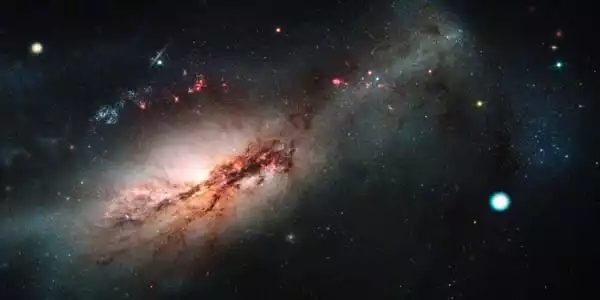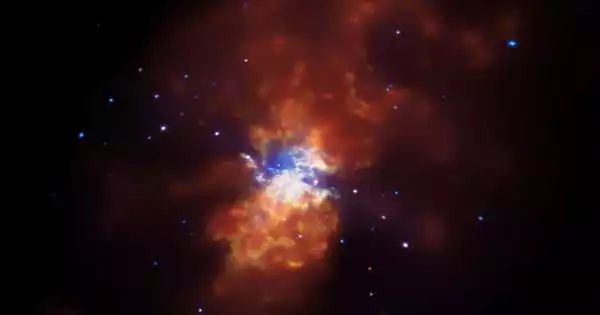Previously, astronomers assumed that red supergiant stars went dormant toward the end of their lives. According to a new study, red supergiant stars can erupt violently before falling into supernovae. Astronomers have photographed in real-time the dramatic end of a red supergiant’s life for the first time, witnessing the enormous star’s rapid self-destruction and final death throes before collapsing into a type II supernova.
The team, led by experts from Northwestern University and the University of California, Berkeley (UC Berkeley), studied the red supergiant over its final 130 days before exploding.
The revelation contradicts earlier theories about how red supergiant stars grow before bursting. Earlier observations revealed that red supergiants were very quiet before dying, with no indication of dramatic eruptions or brilliant emissions. However, the latest observations discovered strong radiation from a red supergiant in its final year before exploding. This implies that at least some of these stars must experience severe internal structural changes, resulting in the chaotic expulsion of gas just before they collapse.
“This is a breakthrough in our understanding of what huge stars do moments before they die,” said the study’s main author, Wynn Jacobson-Galán. “In an ordinary type II supernova, direct observation of pre-supernova activity in a red supergiant star has never been observed before. For the first time, we watched a red supergiant star explode.”
The discovery was published in The Astrophysical Journal.
This significant discovery of a red supergiant supernova is yet another strong indication of the importance of Northwestern’s investment in access to top private telescope facilities, including the Keck Observatory.
Vicky Kalogera
Despite the fact that the research was done at Northwestern University, where Jacobson-Galán was a National Science Foundation (NSF) Graduate Research Fellow, he has since gone to UC Berkeley. Deanne Coppejans, Charlie Kilpatrick, Giacomo Terreran, Peter Blanchard, and Lindsay DeMarchi, all of whom work at Northwestern’s Center for Interdisciplinary and Exploratory Research in Astrophysics, are among the co-authors (CIERA).
‘We’ve never confirmed such violent activity’
The doomed enormous star was discovered in summer 2020 by the University of Hawaii Institute for AstronomyPan-STARRS in Haleakal?, Maui, using the massive amount of light emitted by the red supergiant. A supernova would light up the sky a few months later, in the fall of 2020.
Using the W.M. Keck Observatory’s Low Resolution Imaging Spectrometer on Maunakea, Hawaii, the team immediately caught the intense flash and obtained the first spectra of the energetic explosion, called supernova 2020tlf (SN 2020tlf). The data revealed direct evidence of thick circumstellar material encircling the star at the moment of the explosion, which was most likely the same gas that Pan-STARRS had observed the red supergiant star violently ejecting earlier in the summer.

“It’s like witnessing a ticking time bomb,” said Raffaella Margutti, the paper’s principal author and an adjunct associate professor at CIERA. “Until now, we’ve never confirmed such intense activity in a dying red supergiant star, where we watch it emit such a brilliant emission, then collapse and combust.”
Following the explosion, the team proceeded to monitor SN 2020tlf. Based on data from Keck Observatory’s Deep Imaging and Multi-Object Spectrograph and Near Infrared Echellette Spectrograph, the researchers determined that SN 2020tlf’s progenitor red supergiant star was 10 times more massive than the sun and was located in the NGC 5731 galaxy about 120 million light-years away from Earth.
Remote possibilities
Margutti and Jacobson-Galán did the majority of the research while at Northwestern, where Margutti was an associate professor of physics and astronomy and a member of CIERA, and Jacobson-Galán was a graduate student in Margutti’s research group. Margutti is presently an associate professor of astronomy and astrophysics at the University of California, Berkeley.
Northwestern’s remote access to the telescopes at Keck Observatory was critical to their research. Astronomers can communicate with an on-site telescope operator in Hawaii from the University’s Evanston campus and decide where to place the telescope. Astronomers save valuable observing time by avoiding long-distance travel to Hawaii, often catching ephemeral occurrences like supernovas, which can suddenly flare up and then vanish.
“This significant discovery of a red supergiant supernova is yet another strong indication of the importance of Northwestern’s investment in access to top private telescope facilities, including the Keck Observatory,” said Vicky Kalogera, director of CIERA and the Daniel I. Linzer Distinguished University Professor of Physics and Astronomy at Northwestern’s Weinberg College of Arts and Sciences. “As CIERA researchers have demonstrated since our Keck relationship began just a few years ago, the Keck telescopes, which are now the best on our planet, uniquely permit scientific advances of this quality.”
Margutti, Jacobson-Galán, and their Northwestern colleagues are part of the Young Supernova Experiment, which employs the Pan-STARRS telescope to see supernovae as they erupt.
“I am most excited by all of the new ‘unknowns’ that this discovery has revealed,” Jacobson-Galán stated. “Detecting more events like SN 2020tlf will have a significant impact on how we characterize the final months of stellar evolution, unifying observers and theorists in the effort to answer the puzzle of how huge stars spend their final moments.”
NASA, the National Science Foundation, the Heising-Simons Foundation, the Canadian Institute for Advanced Research, the Alfred P. Sloan Foundation, and VILLUM FONDEN all contributed to the research.
















